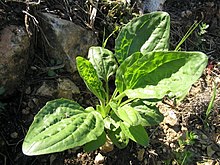Plantago: Difference between revisions
| Line 145: | Line 145: | ||
File:Plantago-maritima-flowers.JPG|''Plantago maritima'' |
File:Plantago-maritima-flowers.JPG|''Plantago maritima'' |
||
</gallery> |
</gallery> |
||
==References== |
|||
{{Reflist}} |
|||
==External links== |
==External links== |
||
Revision as of 08:45, 30 January 2012
| Plantago | |
|---|---|

| |
| Greater Plantain (Plantago major) | |
| Scientific classification | |
| Kingdom: | |
| (unranked): | |
| (unranked): | |
| (unranked): | |
| Order: | |
| Family: | |
| Subfamily: | |
| Genus: | Plantago |
| Subgenera | |
|
Plantago | |
| Synonyms | |
|
Psyllium Mill.[1] | |
Plantago is a genus of about 200 species of small, inconspicuous plants commonly called plantains. They share this name with the very dissimilar plantain, a kind of banana. Most are herbaceous plants, though a few are subshrubs growing to 60 cm (23.5 in) tall. The leaves are sessile, but have a narrow part near the stem which is a pseudo-petiole. They have three or five parallel veins that diverge in the wider part of the leaf. Leaves are broad or narrow, depending on the species. The inflorescences are borne on stalks typically 5–40 cm (2.25-15.75 in) tall, and can be a short cone or a long spike, with numerous tiny wind-pollinated flowers.
Plantains are used as food plants by the larvae of some species of Lepidoptera (butterfly and moth) - see list of Lepidoptera that feed on plantains.
They are found all over the world, including America, Asia, Australia, New Zealand, Africa and Europe. Many species in the genus are cosmopolitan weeds. They are found in many different habitats, most commonly in wet areas like seepages or bogs. They can also be found in alpine and semi-alpine or coastal areas. The cosmopolitan weeds can be frequently seen at the side of roads.
Uses
This article needs additional citations for verification. (April 2008) |
Plantago species have been used since prehistoric times as herbal remedies. The herb is astringent, anti-toxic, antimicrobial, anti-inflammatory, anti-histamine, as well as demulcent, expectorant, styptic and diuretic.[citation needed] Externally, a poultice of the leaves is useful for insect bites, poison-ivy rashes, minor sores, and boils. In folklore it is even claimed to be able to cure snakebite. Internally, it is used for coughs and bronchitis, as a tea, tincture, or syrup. The broad-leaved varieties are sometimes used as a leaf vegetable for salads, green sauce, et cetera.
Plantain seed husks expand and become mucilaginous when wet, especially those of P. psyllium, which is used in common over-the-counter bulk laxative and fiber supplement products such as Metamucil. P. psyllium seed is useful for constipation, irritable bowel syndrome, dietary fiber supplementation, and diverticular disease. Plantain has been consumed as human food since prehistory. For example, archaeological recovery along California's Central Coast has demonstrated use of this species as a food since the Millingstone Horizon.[2]
Psyllium supplements are typically used in powder form, along with adequate amounts of fluids. A dose of at least 7 grams daily taken with adequate amounts of fluid (water, juice) is used by some for management of elevated cholesterol. There are a number of psyllium products used for constipation. The usual dose is about 3.5 grams twice a day. Psyllium is also a component of several ready-to-eat cereals.
In India, mucilage from Desert Indianwheat (Plantago ovata) is obtained by grinding off the husk. The mucilage is sold as Isabgol, a laxative which is used to control irregular bowel syndrome and constipation.[citation needed] It has been used as an indigenous Ayurvedic and Unani medicine for a whole range of bowel problems.
As Old English Wegbrade the plantago is one of the nine plants invoked in the pagan Anglo-Saxon Nine Herbs Charm, recorded in the 10th century. In Romania and Bulgaria, leaves from Plantago major are used as a folk remedy to preventing infection on cuts and scratches because of its antiseptic properties. In Slovenia and other Central European regions, the leaves were traditionally used topically as a cure for blisters resulting from friction (such as caused by tight shoes etc.).
There may also be a use for plantains in the abatement of enteric methane from ruminants,[3] as the natural compounds present (e.g. condensed tannins; ~14g/kg DM), affect the acetate-propionate ratio in the rumen which is a primary mechanism by which methanogenesis is restricted.[4] Currently this is not a viable option in any significant scale due to agronomic difficulties.
Species
The boundaries of the genus Plantago have been fairly stable, with the main question being whether to include Bougueria (one species from the Andes) and Littorella (2–3 species of aquatic plants).[5]
There are about 200 species of Plantago, including:
Gallery
-
Plantago alpina
-
Ribwort plantain (Plantago lanceolata)
-
Ribwort Plantain (Plantago lanceolata)
-
Plantago nivalis
-
Ribwort Plantain flower spike
-
Buckshorn Plantain (Plantago coronopus)
-
Plantago media stepposa
-
Plantago maritima
References
- ^ "Genus: Plantago L." Germplasm Resources Information Network. United States Department of Agriculture. 2006-04-20. Retrieved 2011-03-04.
- ^ C.Michael Hogan (2008) Morro Creek, ed. by A. Burnham
- ^ Ramírez-Restrepo, C. and T. Barry (2005) 'Alternative temperate forages containing secondary compounds for improving sustainable productivity in grazing ruminants', Animal Feed Science and Technology, 120(3-4), 179-201.
- ^ Lourenço, M., G. Van Ranst, B. Vlaeminck, S. De Smet, and V. Fievez (2008) 'Influence of different dietary forages on the fatty acid composition of rumen digesta as well as ruminant meat and milk', Animal Feed Science and Technology, 145(1-4), 418-437.
- ^ Albach, D. C., Meudt, H. M. & Oxelman, B. 2005. Piecing together the "new" Plantaginaceae. American Journal of Botany 92: 297–315.
External links
- Common Plantain, from Mrs. Grieve's herbal
- Medicinal uses of P. major in Armenia
- Additional information about psyllium, including growing procedure and economic value
- Edibility of Plantago: Visual identification and edible parts of wild plantago.








